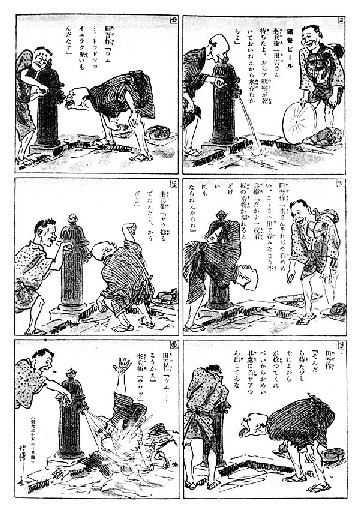| architecture |
| calligraphy |
| ceramics |
| clothing |
| comics |
| gardens |
| lacquerwork |
| literature |
| movies |
| music |
| painting |
| poetry |
| sculpture |
| tea ceremony |
| television |
| theatre |
| weaponry |
| thematic routes |
| timeline |
| the site |

|
the first comic strip with regular characters |
context: comics
History/Roots
The term manga was coined in the early 19th Century by Hokusai for his quick sketches, known as cartoons in western-art terms. Toba-e was used before that - here's why - and then ponchi-e. This term was from a Japanese version of Punch, which ran from 1862-87. Its sales were small, but it was very influential. It had the first use of word balloons in Japan.
As in America, it was around the start of the 20th Century that newspaper strips became important - and the 4-panel gag format has been a mainstay of the form ever since. 'Tagosaku to Mokube no Tokyo Kembutsu' by the great Rakuten Kitazawa in 1902 was the first with regular characters, a couple of bumpkins in the city.
In the 1920s we get the first book collections of strips - one went through over 100 printings in a decade, which shows how popular they were. The first longer stories (a jump to about 20 pages an episode) appeared in the '30s. These were collected in hardbacks, in colour, with slipcases, and some are still loved (especially the tales of Norakuro by Suiho Tagawa). After the defeat in WWII in 1945, the country was flooded by American comics, at the height of their commercial success.
The modern history of comics in Japan perhaps starts there, and the section on Osamu Tezuka rather picks up the story. They are totally established now - since 2000, manga have been a mandatory subject in junior high schools in Japan, presented as a part of the history of narrative art.
backwards: Why are manga so sucessful?
forwards: Subjects
